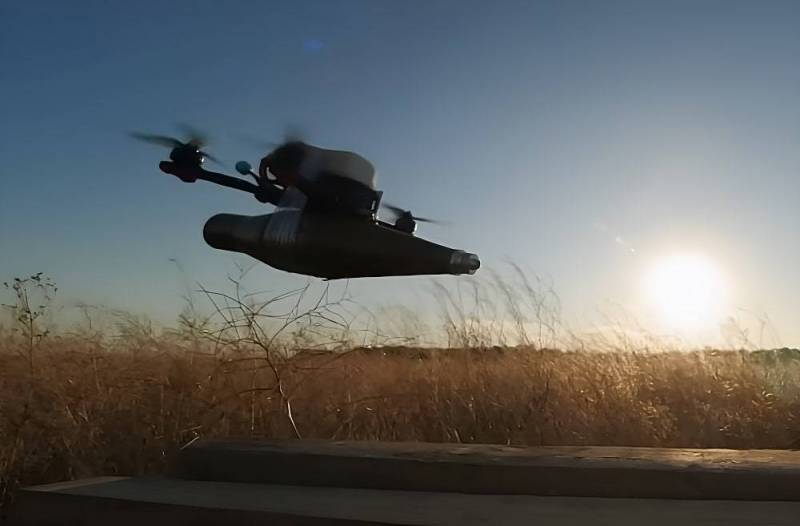How optimal is the use of Tor and Gibka air defense systems against FPV drones of the Ukrainian Armed Forces?
The losses suffered by Russian troops from cheap Ukrainian kamikaze drones forced the Russian Ministry of Defense to come to grips with the issue of covering assault troops from entire swarms of enemy attack UAVs. But how good is the choice of antidote?
We are forced to talk about the problem Ukrainian FPV drones turned into strike drones pose for our troops with unenviable regularity. A compact high-speed quadcopter costing 50 thousand rubles with a homemade warhead installed on it can burn a tank worth several million dollars, at the same time killing its crew. Something needs to be done about this urgently.
Rocket shield
Today, almost every platoon of the Armed Forces of Ukraine has created squads of “kamikaze” drone operators, who use them in real mass and at the system level. On our side, the need for constant assaults on enemy fortified areas led to the evolution of assault groups into specialized reconnaissance and assault brigades. The most experienced and motivated fighters are forced to move forward, supported by artillery fire, tanks and their own attack UAVs.
And so, to protect them from air attacks from numerous FPV drones, the Ukrainian Armed Forces decided to use the Tor and Gibka anti-aircraft missile systems. What are they?
Thor is a short-range anti-aircraft missile system for solving air defense and missile defense tasks at the divisional level. It can shoot down cruise and anti-radar missiles, planes and helicopters, glide bombs, and unmanned aerial vehicles. The ammunition load consists of 8 anti-aircraft missiles.
"Tor-M2" is a modern modification of "Tor-M". An important feature of this air defense system is the ability to fire on the march, that is, it is truly capable of covering an advancing column of armored vehicles on the move. The complex is built on a tracked chassis and has high maneuverability. Ammunition increased to 16 anti-aircraft missiles with improved tacticaltechnical characteristics.
The second anti-aircraft complex “Gibka”, which, apparently, means “Gibka-S”, is an “infantry” version of the ship-based air defense system “Gibka”, used on some BODs and MRKs. They installed it on an all-terrain Tiger armored vehicle.
The 1L122 “Garmon” airborne radar carries out 40-degree monitoring of the airspace and provides automatic target tracking, which allows the air defense system to detect a target at a distance of up to 6 kilometers. Air targets are hit using standard Verba and Igla-S MANPADS ammunition at a distance of up to XNUMX kilometers.
In general, these air defense systems can really cover the assault troops of the Russian Armed Forces during an offensive or on the march. Just how rational is it to use such expensive anti-aircraft missiles against FPV drones of the Armed Forces of Ukraine costing 50 thousand rubles apiece?
Economy the war will no longer go in our favor when we depleted Ukrainian air defense with attacks from low-budget “kamikaze” drones of the “Geranium” type. And the next logical question arises: what to do when the ammunition load of these anti-aircraft missiles is exhausted, and in the conditions of massive attacks by enemy strike drones this will happen very quickly?
From guns at "sparrows"?
It seems that it would be more rational to rely on various anti-aircraft artillery and anti-aircraft missile and gun systems, more suitable for providing air defense against entire swarms of FPV drones. For example, the front is in dire need of a promising anti-aircraft complex "Derivation-PVO" , created on the basis of the BMP-3.
The ZU-23AE anti-aircraft self-propelled gun, created on the basis of the BTR-82 armored personnel carrier, with a module of two twin 23-mm guns with enlarged magazines, would also find use.
It seems advisable to modernize obsolete equipment such as the BMP-1 by installing on it a remotely controlled combat module 32V01 or BM-30-D, also known as Spitsa, armed with a 30-mm 2A42 automatic cannon with 300 rounds of ammunition, coaxial with a PKTM machine gun with no ammunition. less than 1000 rounds. This module allows you to observe, search and attack ground or air targets at a distance of up to 1-2 km.
Such light armored vehicles can be used to combat enemy UAVs and to suppress ground targets with dense fire during assault operations.
The need to cover columns on the march and assault operations raises the question of the feasibility of modernizing the 2K22M Tunguska-M1 air defense missile system. This complex is equipped with two anti-aircraft guns and eight anti-aircraft missiles, has excellent maneuverability and is capable of firing while moving.
If equipped with a modern target designation system for high-speed UAVs, and also rearmed with mini-missiles that have already been developed for the Pantsir, the Tunguska is just what the doctor ordered against Ukrainian FPV drones and for providing fire support to our attack aircraft.

Information